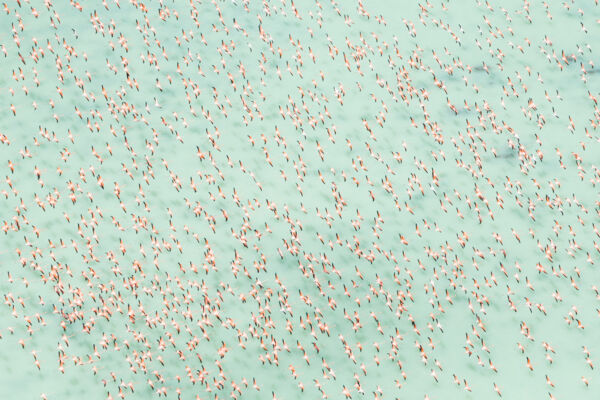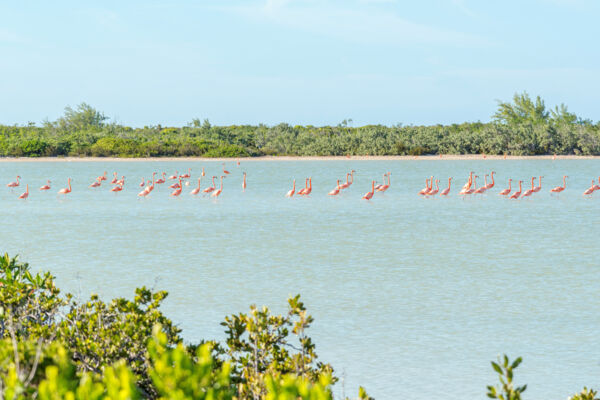Turks and Caicos Flamingos
The Turks and Caicos is an archipelago of more than 100 named islands, cays, and rocks, and a defining characteristic of our islands are the countless marine ponds, estuaries, and channels that are found on nearly every island. Consequently, and due to our location in the tropical Atlantic and near the Caribbean, the American flamingo, (Phoenicopterus ruber), also known as the West Indian flamingo or Caribbean flamingo, is found throughout the country.
Flamingos are common in the Turks and Caicos, but it’s not confirmed that nesting takes place in the country. Young flamingos have been spotted on East Caicos and West Caicos, so it is possible. The Bahamian island of Great Inauga, home to the world’s largest American flamingo colony, is actually located quite close to the Turks and Caicos, at only 40 miles (64 km) away, so it’s also possible that they transited from the Bahamas.
The Best Places to See Flamingos in the Turks and Caicos
| American Flamingo | |
| Common name | Caribbean flamingo American flamingo West Indian flamingo |
| Binomial name | Phoenicopterus ruber |
| Global conservation status | Least concern |
| Conservation status in TCI | Stable |
| Distribution in TCI | Somewhat common, population of about 5300 |
| Mature size | About 47 inches (120 cm) in height |
When seeking a flamingo sighting in the Turks and Caicos, in a broad sense, birdwatching locations can be split into two categories: easily accessible sites, and remote sites. As may be expected, some of the remote areas offer exceptional habitats, yet are not really an option for casual tourists.
Accessible Flamingo Sighting Locations
Providenciales
Providenciales, the main tourism island in the Turks and Caicos, typically doesn’t experience the large flamboyances of flamingos that some of our less-populated islands see, yet there are a few spots where sightings are possible.
The ponds at the Royal Turks and Caicos Golf Club usually have a few flamingos, some ducks, egrets, and herons. Turtle Lake, Flamingo Lake, and Juba Sound, which is a system of saline ponds located near Turtle Tail and Venetian Road, also have limited numbers of flamingos at times. Another spot that may have flamingos is the section of Cheshire Hall Creek fronting Mangrove Bay Restaurant.
North Caicos and Middle Caicos
North Caicos and Middle Caicos both offer a great probability of spotting flamingos.
On North Caicos, Flamingo Pond Overlook near Whitby offers the best chances, and is the best easily-accessible spot in the country where you could expect to see large numbers.
Also on North Caicos are Pumpkin Bluff Pond and Mud Pond, which are expansive and shallow ponds on the north-western side of North Caicos, and definitely worth at least a quick visit by birdwatchers visiting our central Garden Islands. A road leads along the northern side of the pond and allows for great views, so no hiking is necessary. Sightings typically include flamingos, West Indian Whistling ducks, white-cheeked pintail ducks, stilts, reddish egrets, tricolored herons, and more.
On Middle Caicos, the rather small Village Pond and Montpeller Pond, which are located between the communities of Conch Bar and Bambarra, often have a few flamingos to see.
South Caicos
The central salt salinas on South Caicos offer great birdwatching opportunities, and relatively approachable flamingos can usually be seen, along with herons, egrets, and smaller coastal birds.
The scenic coastal environments of The Highlands and Plandon Cay Cut are great for birdwatching, yet it’s hard to do better than the central salinas when seeking flamingos.
Grand Turk
Grand Turk, home to our capital city of Cockburn Town and once the center of activity in the Turks and Caicos, was once a sea salt producing island, and consequently has a number of disused salinas. As is the same case with South Caicos, these shallow ponds attract birds. Flamingos can be seen in nearly any of the salinas at various times, and are less skittish than those found in the wilds, as they are accustomed to people.
Another decent spot for birds is the shallows off the northwest of the island. This area, near the inlet into North Creek and the Grand Turk Lighthouse, offers ideal feeding grounds for wading birds.
Salt Cay
The small island of Salt Cay features many abandoned salt salinas and natural wetlands, which when combined with its isolated location, create an exceptional birdwatching destination. Flamingos and many other types of birds can be seen throughout the island.
A great place to start is the shallow tidal waterways at North Creek and South Creek. These exquisite creeks connect to the ocean on the eastern side of the cay, and the diversity of the environment is conducive for sighting both bird and marine wildlife.
Remote Flamingo Sighting Locations
Several remote spots in the Turks and Caicos can attract large numbers of flamingos, often into the hundreds.
Lake Catherine on West Caicos
Lake Catherine, an inland system of saline ponds on West Caicos and a nature reserve, is a spectacular and scenic attraction, especially when considered with the adjacent Yankee Town historical site.
The eastern side of the pond system, which is largely muddy and quite shallow, can have hundreds of flamingos at times, presenting a bright pink contrast to the gray silty mud. The western side of the system, which is deeper, is a brilliant turquoise, and the site of several complex and tidal underwater cave systems, will also often have some flamingos, albeit in few numbers. The area is likewise excellent for spotting the larger herons and egrets.
East Caicos
The remote island of East Caicos is one of the largest uninhabited islands in the Lucayan Archipelago, and is an exceptional haven for bird and marine life. East Caicos supports countless wetland systems, many of which feature underwater Karst Process cave features, which results in a surprising diversity of wetland micro environments that span the island.
Most of the ponds on the Northern side of the island support flamingos, with the concentrations of birds appearing to increase progressively to the east. At Drum Point, the northeast-most point of the island, it’s typical to see large flocks of 100-200.
The beautiful tidal mangrove channels between East Caicos, Hog Cay, and South Caicos is probably the finest birdwatching location in the Turks and Caicos, and it’s common to spot flamingos, spoonbills, frigatebirds, ospreys, and egrets and herons of many types.
Ramsar Nature Reserve
The Ramsar Nature Reserve is a complex and expansive protected area, located on the southern coast wetlands of North Caicos, Middle Caicos, and East Caicos. The majority of the red mangrove systems in the Turks and Caicos are included in this nature reserve. Isolated groups of 20-150 flamingos can be seen at some of the sheltered inland ponds, or flying at low altitudes as they migrate between ponds.
Pigeon Pond
Pigeon Pond is an inland high salinity pond that is part of the greater Pigeon Pond and Frenchman’s Creek Nature Reserve on the southwestern coast of Providenciales.
Also in the nature reserve and near Pigeon Pond is Flamingo Creek Bay. As its name indicates, the creek near the beach often has limited numbers of flamingos and other wading birds.
Proggin’ Bay
Proggin’ Bay, a shallow and muddy saline pond located inside the Frenchman’s Creek Nature Reserve on the southwest of Providenciales, occasionally has 5-50 flamingos, which tend to congregate on the eastern end of the pond. The general area is quite scenic, as the pond can have glistening salt crystals on its western end, and the eastern side is a striking red that contrasts with the turquoise of the Caicos Banks.
Birdwatching Etiquette
When watching and photographing birds, it’s important to not disturb wildlife or cause any environmental damage. Flamingos have been protected in the Turks and Caicos for more than a century, and probably longer than any other animal. See Environment and Conservation.
Please stay on established paths, and don’t approach wildlife. Some protected areas in the Turks and Caicos may have restricted access, and prior approval is required to enter them. It’s illegal to take or damage any natural or historical object in protected areas, which includes national parks, nature reserves, and historical sites.




